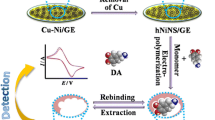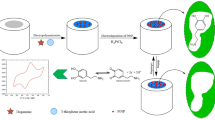Abstract
Three-dimensional structures comprising polypyrrole nanowires (PPyNWs) and molecularly imprinted polymer (MIP) were prepared by electropolymerization on the surfaces of a glassy carbon electrode (GCE). The modified GCE possesses both large surface area and good electrocatalytic activity for oxidizing dopamine (DA), and this leads to high sensitivity. The electropolymerized MIP has a large number of accessible surface imprints, and this makes the GCE more selective. Under optimal conditions and at a working voltage of typically 0.23 V (vs. SCE), the calibration plot is linear in the 50 nM to 100 μM DA concentration range, and the limit of detection is 33 nM. The sensor has been successfully applied to the analysis of DA in injections.

Schematic of a three-dimensional nanocomposite based dopamine sensing platform based on the use of a molecularly imprinted polymer and poly(pyrrole) nanowires. The modified polypyrrole nanowires and molecularly imprinted polymer endowed high electrocatalytic capacity and good selectivity for dopamine recognition, respectively.





Similar content being viewed by others
References
Downard AJ, Roddick AD, Bond AM (1995) Covalent modification of carbon electrodes for voltammetric differentiation of dopamine and ascorbic acid. Anal Chim Acta 317:303–310
Orr CF, Rowe DB, Halliday FM (2002) An inflammatory review of Parkinson’s disease. Prog Neurobiol 68:325–340
Ali SR, Ma Y, Parajuli RR, Balogun Y, Lai YC, He H (2007) A nonoxidative sensor based on a self-doped polyaniline/carbon nanotube composite for sensitive and selective detection of the neurotransmitter dopamine. Anal Chem 792:583–587
Sas S, Blank CL (1977) Determination of serotonin and dopamine in mouse brain tissue by high performance liquid chromatography with electrochemical detection. Anal Chem 49:354–359
Saraji M, Shahvar A (2016) Selective micro solid-phase extraction of epinephrine, norepinephrine and dopamine from human urine and plasma using aminophenylboronic acid covalently immobilized on magnetic nanoparticles followed by high-performance liquid chromatography-fluorescence detection. Anal Methods 8:830–839
Tao Y, Lin Y, Ren J, Qu X (2013) A dual fluorometric and colorimetric sensor for dopamine based on BSA-stabilized aunanoclusters. Biosens Bioelectron 42:41–46
Teng Y, Jia X, Li J, Wang E (2015) Ratiometric fluorescence detection of tyrosinase activity ans dopamine using thiolate-protected gold nanoclusters. Anal Chem 87:4897–4902
Qian T, Wu S, Shen J (2013) Facilely prepared polypyrrole-reduced graphite oxide core-shell microspheres with high dispersibility for electrochemical detection of dopamine. Chem Commun 49:4610–4612
Hsu MS, Chen YL, Lee CY, Chiu HT (2014) Gold nanostructures on flexible substrates as electrochemical dopamine sensors. ACS Appl Mater Interfaces 4:5570–5575
Wightman RM, May LJ, Michael AC (1988) Detection of dopamine dynamics in the brain. Anal Chem 60:769A–793A
Kim YR, Bong S, Kang YJ, Yang Y, Mahajan RK, Kim JS, Kim H (2010) Electrochemical detection of dopamine in the presence of ascoribic acid using graphene modified electrodes. Biosens Bioelectron 25:2366–2369
Tan L, Zhou KG, Zhang YH, Wang HX, Wang XD, Guo YF, Zhang HL (2010) Nanomolar detection of dopamine in the presence of ascorbic acid at β-cyclodextrin/graphene nanocomposite platform. Electrochem Commun 12:557–560
Wulff G (1995) Molecular imprinting in cross-linked materials with the aid of molecular templates-a way towards artificial antibodies. Angew Chem Inter Ed 34:1812–1832
Erdőssy J, Horváth V, Yarman A, Scheller FW, Gyurcsányi RE (2016) Electrosynthesized molecularly imprinted polymers for protein recognition. TrAC Trends Anal Chem 79:179–790
Kuwata T, Uchida A, Takano E, Kitayama Y, Takeuchi T (2015) Molecularly imprinted polymer arrays as synthetic protein chips prepared by transcription-type molecular imprinting by use of protein-immobilized dots as stamps. Anal Chem 87:11784–11791
Gu L, Jiang X, Liang Y, Zhou T, Shi G (2013) Double recognition of dopamine based on a boronic acid functionalized poly(aniline-co-anthranilic acid)-molecularly imprinted polymer composite. Analyst 138:5461–5469
Prasad BB, Jauhari D, Tiwari MP (2013) A dual-template imprinted polymer-modified carbon ceramic electrode for ultra trace simultaneous analysis of ascorbic acid and dopamine. Biosens Bioelectron 50:19–27
Zeng Y, Zhou Y, Kong L, Zhou T, Shi G (2013) A novel composite of SiO2-coated graphene oxide and molecularly imprinted polymers for electrochemical sensing dopamine. Biosens Bioeletron 45:25–33
Xue C, Han Q, Wang Y, Wu J, Wen T, Wang R, Hong J, Zhou X, Jiang H (2013) Amperometric detection of dopamine in human serumby electrochemical sensor based on gold nanoparticles doped molecularly imprinted polymers. Biosens Bioelectron 49:199–203
Lakshmi D, Bossi A, Whitcombe MJ, Chianella I, Fowler SA, Subrahmanyam S, Piletska EV, Piletsky SA (2009) Electrochemical sensor for catechol and dopamine based on a catalytic molecularly imprinted polymer-conducting polymer hybrid recognition element. Anal Chem 81:3576–3584
Teng Y, Fan L, Dai Y, Zhong M, Lu X, Kan X (2015) Electrochemical sensor for paracetamol recognition and detection based on catalytic and imprinted composite film. Biosens Bioelectron 71:137–142
Dai Y, Li X, Lu X, Kan X (2016) Voltammetric determination of paracetamol using a glassy carbon electrode modified with Prussian blue and a molecularly imprinted polymer, and ratiometric read-out of two signals. Microchim Acta 183:2771–2778
Wang K, Wu H, Meng Y, Wei Z (2014) Conducting polymer nanowire arrays for high performance supercapatitors. Small 10:14–31
Abidian MR, Kim DH, Martin DC (2006) Conducting-polymer nanotubes for controlled drug release. Adv Mater 18:405–409
Rahman MA, Son JI, Won MS, Shim YB (2009) Gold nanoparticles doped conducting polymer nanorod electrodes: ferrocene catalyzed aptamer-based thrombin immunosensor. Anal Chem 81:6604–6611
Hui N, Chai F, Lin P, Song Z, Sun X, Li Y, Niu S, Luo X (2016) Electrodeposited conducting polyaniline nanowires arrays aligned on carbon nanotubes network for high performance supercapacitors and sensors. Electrochim Acta 199:234–241
Lin M, Cho M, Choe WS, Yoo JB, Lee Y (2010) Polypyrrole nanowire modified with Gly-Gly-his tripeptide for electrochemical detection of copper ion. Biosens Bioelectron 26:940–945
Lindfors T, Latonen RM (2014) Improved charging/sidcharging behavior of electropolymerized nanostructured composite films of polyaniline and electrochemically reduced graphene oxide. Carbon 69:122–131
Komiyama H, Komura M, Akimoto Y, Kamata K, Iyoda T (2015) Longitudinal and lateral integration of conducting polymer nanowire arrays via block-copolymer-templated electropolymerization. Chem Mater 27:4972–4982
Acknowledgements
We greatly appreciate the support of the National Natural Science Foundation of China (21575003) and Foundation for Innovation Team of Bioanalytical Chemistry of Anhui Province.
Author information
Authors and Affiliations
Corresponding author
Ethics declarations
The author(s) declare that they have no competing interests.
Additional information
Ying Teng and Fen Liu Co-first authors
Electronic supplementary material
ESM 1
(DOC 1215 kb)
Rights and permissions
About this article
Cite this article
Teng, Y., Liu, F. & Kan, X. Voltammetric dopamine sensor based on three-dimensional electrosynthesized molecularly imprinted polymers and polypyrrole nanowires. Microchim Acta 184, 2515–2522 (2017). https://doi.org/10.1007/s00604-017-2243-y
Received:
Accepted:
Published:
Issue Date:
DOI: https://doi.org/10.1007/s00604-017-2243-y




